Overview of the Service Ontario
The ServiceOntario, a public service ministry in Ontario, has an estimated 2, 400 employees. The leadership of ServiceOntario is under 150 managers who manage front line support staff and oversee management of the ministry. The diversity and inclusion strategy of ServiceOntario is run by two independent committees namely the Executive Management Committee (EMC) and the Senior Management Committee (SMC). The EMC and SMC are responsible for diversity and inclusion strategy technical resources.
Background
Implementation of a Diversity and inclusion strategy in the workplace positions an organization to demonstrate commitment to employee welfare. The baseline for implementation of the Integration of diversity and inclusion strategy should be based on the construct of organizational strategy, business strategy, and corporate strategy (Kalev et al, 2006). The outcome of integrating diversity and inclusion strategy into the development of employee management strategies facilitates the creation of value to dispute management programs, employee recruiting policies and promotions, employee training and development programs, and employee relations services. The relationship is summarized by the following hypothesis:
- Hypothesis 1A: The baseline for implementation of Diversity and Inclusion Strategy influences organizational framework for employee relations management, recruitment and promotion practices
- Hypothesis 1B: the baseline for implementation of Diversity and Inclusion Strategy determines the capacity of employees to demonstrate organizational citizenship behavior
- Hypothesis 1C: the baseline for implementation of Diversity and Inclusion Strategy gains value if it is integrated into the organization strategy, business strategy and corporate strategy.
Diversity and inclusion strategy contribute to an organization’s capability to gain value from employee ownership which enhances employee retention, decreases employee turnover, and positions employees to demonstrate organizational citizenship behavior (Anderson & Metcalf, 2005). Diversity and inclusion strategy have been identified to contribute to organizational capacity to provide psychological contract, hence achievement of psychological capital through the provision of employee motivation and hygienic factors like job security, job flexibility, decreased power distance, development of vertical and horizontal communication channels, and utilization of transformational leadership (Singh et al, 2002). Human resource management practices and alignment of organizational strategies into diversity and inclusion strategy have contributed to the internationalization of business systems and organizational strategies that have paved the way for the convergence of organizational human resource best practices.
Implementation of diversity and inclusion strategy requires the development of learning strategies on roles and relationship between diversity and inclusion strategy and organizational or business strategy (Ospina & Sorenson, 2006). Successful implementation of diversity and inclusion strategy depends on management support for the diversity strategy and organizational culture. This implies an organizational level of accountability for the implementation of the diversity and inclusion strategy plays an important role in the strategy ownership and governance. The organization ought to identify performance metrics for diversity and inclusion strategy that could be used to determine the level of productivity change after implementation, employee organizational citizenship behavior after implementation, and capacity to make the employee responsible for the implementation of the strategy (Cordes, 2005). The organization’s capacity to make employees accountable for implementation should be based on capacity to build employee engagement, ability to link employee remuneration to performance, and level of organizational career development hence achievement of meritocracy.
The organization ought to demonstrate the capacity to address diversity issues that negatively impact diversity and inclusion strategy implementation. This occurs if the organization demonstrates a commitment to build differentiated and heterogeneous talents through cultural barrier management to diversity recruitment and promotion (Daniels, 2004). The organization ought to demonstrate commitment to organizational design that could support the implementation of diversity and inclusion strategy through management of deficiencies that negatively influence diversity and inclusion subject to traditional job designs and career development paths. The influence of diversity and inclusion strategy with regard to an organization-employee relationship is summarized by the hypothesis below:
- Hypothesis 2A: The baseline for implementation of the Diversity and Inclusion Strategy should be structured on the capacity to develop employee competencies through training and development of employees on Diversity and Inclusion issues.
- Hypothesis 2B: communication of Diversity and Inclusion Strategy to employees contributes to organizational capacity to demonstrate employee ownership and commitment to employee welfare.
- Hypothesis 2C: implementation of Diversity and Inclusion Strategy should contribute to cross-cultural best practices in human resource management.
Many public service organizations don’t have a sustainable business case that could be used as a benchmark for the achievement of organizational diversity and inclusion initiatives and strategies (Point & Singh, 2003). The absence of sustainability of a business case has been attributed to a lack of actions that could support organizational strategic goals and objectives. As a result, organizations have continuously suffered from high employee turnover that has resulted in an increase in recruitment costs. The outcome of deficient organizational diversity and inclusion strategy has been decreased productivity, increased victimization of employees, and decreased performance index (Kochan et al, 2003). The organization may be exposed to threats of increasing expenses related to legal costs emerging from employees’ cases ranging from sexual harassment, racial assault and prejudice and homophobia. The organizations lack diversity business development for instance employee dispute management programs, employee relations programs, employee reward schemes and lack of promotion from within the organization for vacancies that open due to organizational expansion may contribute to decreasing employee perception of organizational commitment to utilizing her human capital (Mayo, 2004). Organizations don’t tap the potentials and efficiencies of employee development through internal promotions and recognition awards.
Organizational assessment of predisposing factors to productivity has identified human resource diversity and inclusion plays an important role in organizational networks that foster and nurture innovation, consultation and creativity (Jayne & Dipboye, 2004). The concept of diversity and inclusion of employees creates an environment for improving employee morale, the capacity for the organization to have healthy relations with its employees, and the prevalence of knowledge exchange which is vital for the innovativeness of the organization. Organizations ought to develop policies for managing diversity and inclusion of employees in order to increase employee participation by creating heterogeneous employees where racial segregation or sexual harassment and discrimination are not common incidents (Choi & Rainey, 2010). There is a demand for an organization to demonstrate commitment to diversity and inclusion through the development of systematic approaches to diversity and inclusion and the demonstration of long-term employee commitment (figure 1). As a result, the organization is positioned to serve a diversity of customers and clients. Diversity and inclusion strategy could be implemented through the use of an employee satisfaction model which integrates employee needs, expectations, and opportunities onto the framework for diversity and inclusion strategy (Ospina, 2010a). The hypothesis below summarizes outcomes of the Diversity and Inclusion Strategy
- Hypothesis 3A: implementation of Diversity and Inclusion Strategy provides the foundation for employee satisfaction with their tasks through the delivery of psychological contract hence achievement of benefits associated with psychological capital
- Hypothesis 3B: implementation of Diversity and Inclusion Strategy provides an opportunity for the organization to reduce legal costs arising from legal suits on racial victimization and homophobia
- Hypothesis 3C: development of a framework on Diversity and Inclusion Strategy provides an organizational climate where employees can participate in knowledge exchange hence capacity to nurture organizational workgroups that can participate in innovation through shared knowledge and skills
- Hypothesis 3D: Diversity and Inclusion Strategy implementation contributes to the development of a business case that supports organizational vision and value statement.

Organizations ought to adopt a tactically driven approach towards the implementation of a diversity and inclusion strategy. A tactically driven approach facilitates the determination of employee motivators that could result in employee positive outcomes in terms of performance and productivity (Salomon & Schork, 2003). Organizational capacity to use a tactically driven approach in the implementation of diversity and inclusion strategy has been identified to contribute to increased productivity, decreased employee turnover, and decreased recruitment costs. Organizations fail to achieve economic benefits associated with the implementation of diversity and inclusion strategy due to failure to incorporate education and awareness on diversity and inclusion, lack of management support for diversity and inclusion strategy as part of organizational strategy, lack of capacity building and resource allocation towards implementation of diversity and inclusion strategy, and lack of organizational partnership and networks that could foster knowledge transfer (Kochan et al, 2003).
Many organizations don’t carry out an assessment to determine achievements of diversity and inclusion strategy. Reviews on diversity and inclusion strategy help to identify constraints in the diversity and inclusion strategy through the use of Theory of Constraints hence facilitating the determination of solutions that could manage the deficiencies and constraints by using the six sigma model (Ospina, 2010a). Lack of strategy monitoring tools, therefore, positions the organization to a level where it is not able to measure the results and performance of its diversity and inclusion strategy. There should be support for contextual and linking of strategy to relevant organizational strategies and conventions. Thus, an organization cannot determine if failure to achieve positive outcomes in its investment in diversity strategy might be subject to a lack of supportive managerial resources. This may make an organization fail to know at what point it ought to hire consultancy services (Mayo, 2004).
Technological advancement and the growth and development of social networks as a paradigm for marketing have increased employee awareness of diversity and inclusion issues (McKay et al, 2007). Employees have increased awareness of the rationale for equal opportunities as a work environment that doesn’t compromise discrimination subject to the need for fair and equal treatment. Contrary, organizations limit their compliances to race, sex, and disability acts which have created an environment where positive approaches to diversity and inclusion management could not be accounted for (Armstrong, 2006). As a result, the organization’s returns on investment continue to decrease. Diversity and inclusion strategy implementation should be a continuous process subject to ongoing measurements and results assessment (figure 2). The immediate hypothesis summarizes opportunities that could arise following the implementation of the Diversity and Inclusion Strategy.
- Hypothesis 4A: implementation of Diversity and Inclusion Strategy provides the foundation for cross-cultural, cross-racial and cross-tribal recruitment and equal opportunities for employees
- Hypothesis 4B: implementation of Diversity and Inclusion Strategy provides an opportunity for the organization to continually measure the performance of its Diversity and Inclusion Strategy to identify deficits and areas of improvement
- Hypothesis 4C: implementation of the Diversity and Inclusion Strategy provides an opportunity for integration of employee management strategies into business and organizational strategies.
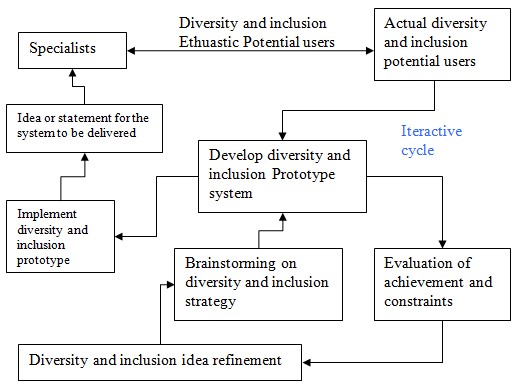
Organizations that have developed a baseline for implementation of diversity and inclusion strategy have not realized employee retention. They don’t demonstrate a high level of employee acquisition (Stiles & Kulvisaechana, 2003). This has impacted negatively returns on investment despite the organization’s investment in work placement programs. The students on attachment don’t demonstrate a willingness to work with the organizations. It has been documented that the organizations fail to provide a psychological contract that influences psychological capital and capacity for an organization to gain value from employee diversity and inclusion strategy (Thomas, 2004). Other factors that have been identified include lack of communication mix, vertical horizontal communication channels which don’t enhance flexibility and consultation, power distance, and cultural factors that fuel inadequacy of diversity and inclusion (figure 3). It has been determined that the failure of a business case to manage internal factors that influence and impact the implementation of diversity and inclusion strategy creates internal environment barriers to diversity and inclusion strategy implementation (Anderson & Metcalf, 2005).
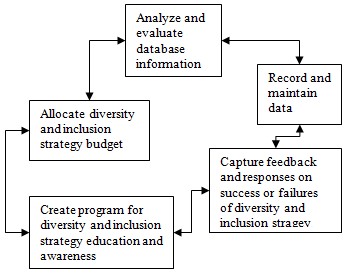
The success of baselining implementation of diversity and inclusion strategy lies in the determination of mechanism through which an organization could promote equality and diversity issues and rationale through which policies are implemented (Coran et al, 2003). Separation of diversity and inclusion strategy from organizational strategy negatively impacts the success of the diversity and inclusion strategy. Organizations often provide a series of training sessions to employees which contribute to the separation of diversity strategy from organizational strategy (Boxall & Purcell, 2003). Organizations fail to communicate that diversity and inclusion strategy is part of organizational strategy. As a result, organizations discriminate diversity and inclusion strategies in their audits which amounts to negative outcomes. The organizational vision and mission statements ought to demonstrate mechanism the organization is oriented towards diversity and inclusion through action plans through which diversity and inclusion strategy is achieved. The immediate hypothesis summarizes the negative impacts of failing to monitor and develop a framework for the Diversity and Inclusion Strategy.
- Hypothesis 5A: implementation of Diversity and Inclusion Strategy should be based on capacity to align organizational strategy and Diversity and Inclusion Strategy in order for the organization to gain value of Diversity and Inclusion Strategy.
- Hypothesis 5A: implementation of Diversity and Inclusion Strategy should be based on capacity to align organizational strategy and Diversity and Inclusion Strategy in order for the organization to gain value of Diversity and Inclusion Strategy
- Hypothesis 5B: implementation of Diversity and Inclusion Strategy requires sufficient allocation of resources that can sustain and run programs on Diversity and Inclusion Strategy
- Hypothesis 5C: the channel of communication impacts negatively on the implementation of the Diversity and Inclusion Strategy and its sustainability
- Hypothesis 5D: employee motivation levels and terms of employment influence the capacity of employees to participate in the implementation of Diversity and Inclusion Strategy hence the capacity of the organization to gain value from Diversity and Inclusion Strategy
This study is based on the baseline that ServiceOntario has utilized to implement diversity and inclusion strategy, identify deliverables for diversity and inclusion strategy, and rationale of baselining implementation of diversity and inclusion strategy (Kalev et al, 2006). The outcome would play a pivotal role in determining and benchmarking the future roadmap for the ServiceOntario with regard to capacity to create a local diversity and inclusion strategy within the resource profile of ServiceOntario.
Goals and objectives
- To determine the baseline that ServiceOntario has used in implementing diversity and inclusion strategy hence or otherwise determine mechanism the ServiceOntario baseline has impacted on leadership and business rationale, strategic planning, and execution of diversity and inclusion strategy
- To identify challenges and constraints that ServiceOntario has encountered in her baseline for implementation of diversity and inclusion strategy
- To determine impacts of diversity and inclusion strategy on organizational efficacy and effectiveness
- To determine the sustainability of a diversity and inclusion strategy as an organizational strategy and mechanism it impacts on leadership and management of organizational, corporate and business strategies.
Expected outcomes of the study
The study findings on baselining implementation of a diversity and inclusion strategy will play a role in improving organizational awareness of diversity and inclusion strategy based on employee equal rights (Armstrong, 2006). The findings of the study will facilitate the organization to determine baseline data that could be used to implement a diversity and inclusion strategy. The findings will contribute to gender equality in promotions, and recruitment and increase the recruitment of minorities. The study findings will contribute to the restructuring of the ServiceOntario diversity and inclusion strategy into a policy that will increase diversity in client service and diversity interaction. The findings will help ServiceOntario to formulate a timeline for reviewing her diversity and inclusion strategy (Jayne & Dipboye, 2004). The findings will result in the development of organizational level focus groups for conducting reviews on diversity and inclusion strategy; improve on the feasibility of diversity and inclusion strategy on basis of planning and representation, sponsorship of employee and minority development (figure 4). The study outcomes will result in new learning opportunities for the management of diversity and inclusion strategy. The findings will contribute to the development of higher expectations for employee performance and the promotion of openness and accountability. The findings will result in the development of a mission statement that promotes diversity and inclusion strategy (Mayo, 2004).

The study findings and implementation of study recommendations for diversity and inclusion strategy would result in decreased employee turnover subject to increased retention rate, improve employee work life cycle in the organization hence the creation of employee lifetime value (Point & Singh, 2003). the findings will contribute to the ongoing implementation of measures that could contribute to employee retention hence decreasing recruitment costs, improving the organizational bottom line, and enhancing support for the organization’s employee retention program (figure 5).
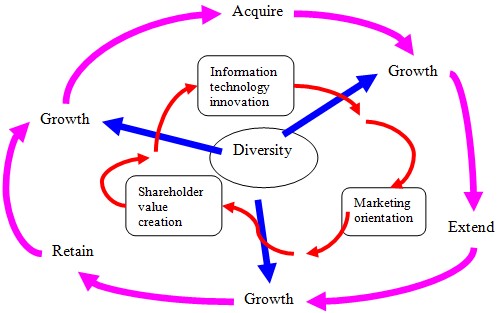
The results and findings will contribute to the development of organizational diversity and inclusion fellowships programs meant to create awareness and educate employees on the position of the organization with regard to the diversity and inclusion strategy (Boxall & Purcell, 2003). The program would highlight the plight of employees that have encountered cultural or socioeconomic barriers in the workplace hence providing the foundation for a restructuring of the diversity and inclusion strategy. The program would provide a rationale for the establishment of a scholarship award to minority communities that demonstrate performance standards that will be set by the organization’s standards for academic awards (Choi & Rainey, 2010). The results will contribute to organizational capability to participate in diversity and inclusion fairs. This will expose employees to standards of diversity and inclusion as applied by different institutions (figure 6). The findings will contribute to the development of employee mentoring programs and induction programs as specified by occupational health and safety standards (Salomon & Schork, 2003). This will contribute to the development of mentor relationship programs that will subsidize roles played by employee relations programs, employee dispute management programs, and employee rewards schemes.
The study findings will result in the integration of diversity and inclusion strategy into the organizational strategy, the development of an organizational culture that values employee individual differences, and provide an environment for an employee to demonstrate full potential. The findings will stimulate the organization to identify key resources that could enhance diversity and inclusion strategy, systems that support diversity and inclusion strategy, and development of procedures for implementing diversity and inclusion strategy (figure 5).

The results would contribute to the development of organizational networks that would result in the exchange of knowledge on diversity and inclusion, facilitate consultation, enhance role modeling and contribute to employee referral programs that have the capacity to attract the best talents in the market (Cornelius & Gagnon, 2004).
Theoretical framework of the study
The study on baselining implementation of a diversity and inclusion strategy was based on the concept of commitment, culture, environment, and performance and mechanism they relate to the process flow approach for the strategic Human resource management and employee diversity and inclusion framework (Stiles & Kulvisaechana, 2003). The study adapted the Unitarist model and integrated the concept of diversity and inclusion strategy in order to form a rationale for utilizing diversity strategy underpinning processes and outcomes post strategy application. The adaptation of the Unitarist model (figure 7) into baselining of diversity and inclusion strategy was meant to identify the degree of organizational commitment and employee ownership hence objective interests of the organization vis-à-vis employee capacity to demonstrate organizational citizenship behavior subject to the satisfaction level of their jobs, training and development opportunity, the masculinity of the work environment or femininity of the work environment, degree of communication with regard to cultural element of power distance and uncertainty, and provision of task flexibility by the organization (Armstrong, 2006). The Unitarist model has the capacity to be used to identify employee behavior and its significance in terms of productivity and task performance hence mechanism of the behavior reflects on employee service to the client base served by the organization.
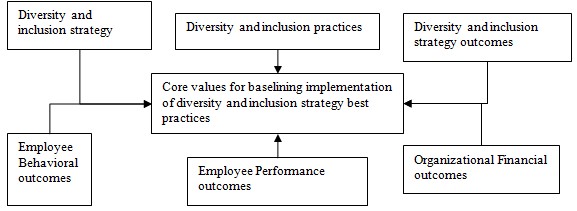
Integration of Pro Mosaic II assessment tool into human resource management via diversity and inclusion strategy provides a structure for building sustainable diversity in the workplace. Pro Mosaic II assessment tool provides an opportunity for the organization to create an internal road map for baselining implementation of diversity and inclusion strategy. It makes it possible for the organization to determine the status of its diversity and inclusion strategy and mechanism diversity and inclusion strategy relates to productivity, individual employee performance and teamwork performance (Kochan et al, 2003). Pro Mosaic II assessment tool provides information on elements that should be considered when internalizing diversity and inclusion strategy. Organizational use of the Pro Mosaic II survey ensures independence of the organization from external intervention when the organization conducts its own self-assessment. Through self-assessment, the organization is able to develop policies that should govern the implementation of diversity and inclusion strategy, improve on strategic planning, and implement initiatives that enhance and create value to diversity and inclusion strategy and identify what could create value to the diversity strategy based on the organizational cultural mix. Outcomes of Pro Mosaic II surveys facilitate continuous improvement in terms of benchmarking her capacity to deliver a sustainable framework for diversity and inclusion strategy which positions the organization to achieve employee ownership and gain from employee retention rate and value. The status of the organizational diversity and inclusion strategy influences stakeholder perception of the organization which creates an opportunity for the organization to demonstrate commitment in ongoing monitoring of the diversity and inclusion strategy. The organization needs to utilize the collaboration model (figure 8) to exploit the values of diversity strategy. The incorporation of the collaborative model enhances the capacity for organizational networks and the transfer of knowledge.
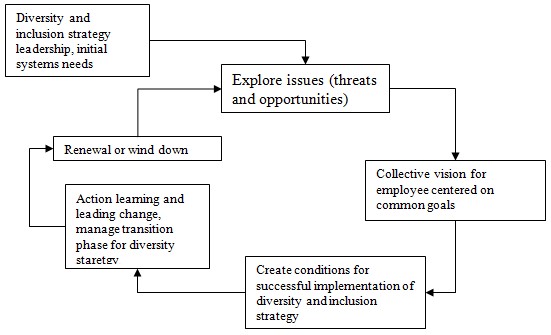
The use of the collaboration model provides an opportunity for the organization to achieve the four core components of the Pro Mosaic II assessment tool hence capacity for the organization to identify opportunities for continuous improvement (figure 9) which translate into increased productivity and performance through the convergence of employee interests and organizational objective interests.
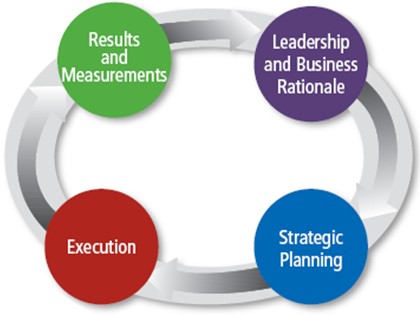
Organization of the dissertation
The previous section provided the background for the study in terms of determination of attributes that impact diversity and inclusion strategy, positive and negative outcomes for failing to adopt diversity and inclusion strategy, and rationale for the implementation of the diversity and inclusion strategy. The rest of the dissertation is organized as follows. Chapter two reports on literature review on diversity and inclusion strategy and mechanism through its diversity and inclusion strategy should be embedded (figure 10). The section reports on research gaps in the implementation of diversity and inclusion strategy and proposes measures that have been deployed to manage challenges that face baselining implementation of a diversity and inclusion strategy. The section concludes by proposing the methodology of the study and why the methodology is more suited in this study. Chapter three, reports on the methodology of the study, and the mechanism the methodology was structured to contribute to the determination of elements that should be considered when developing a baseline for implementation of diversity and inclusion strategy was collected. Chapter three, reports on the results that were obtained after collection of the data using the Pro Mosaic II assessment tool, determines the position of the organizational diversity and inclusion continuum, and discusses the results to identify the organization’s baseline for implementation of the diversity and inclusion strategy. Chapter five reports on whether the study achieved its objectives, accepts or rejects some of the hypotheses for the study, and makes recommendations based on the study findings.
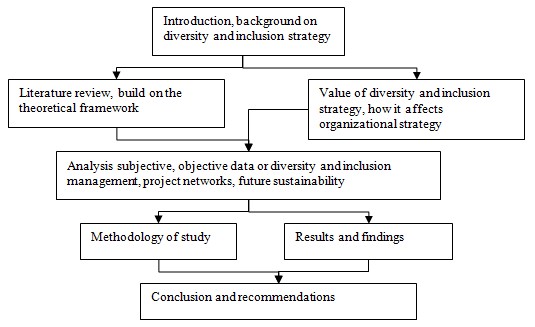
Methodology of the study
This section reports on the method of study that was used to conduct studies on baselining implementation of a diversity and inclusion strategy with regard to ServiceOntario.
Foundation of the Methodology of the study
The study employed an exploratory approach in order to form the foundation for conducting studies on baselining implementation of diversity and inclusion strategy. An exploratory research technique (figure 11) was adopted in order to create independence of the study from past studies on baselining implementation of diversity and inclusion strategy. The exploratory technique was adopted because of the absence of a previous model that could have been used to form the basis for the study construct. An exploratory study is employed when there are no other options for conducting studies on the baseline for implementation of a diversity and inclusion strategy. It could be used when there is a limitation of the application of theories or models on diversity and inclusion strategy implementation (figure 1). As a result, the use of the exploratory approach to carry out studies on the baseline for implementing diversity and inclusion strategy was not based on any existing theory or model because the study was categorical.
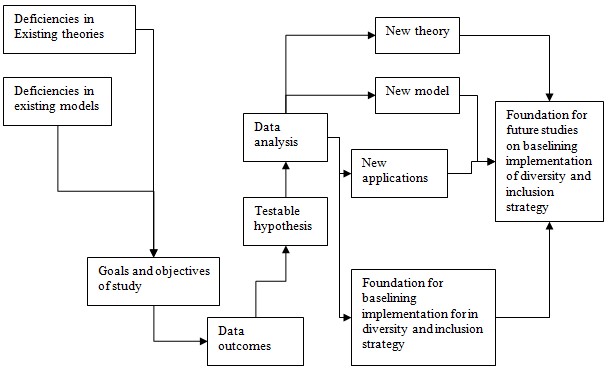
Use of exploratory research was structured to ensure the study outcomes resulted into documentation of ServiceOntario baseline for implementation of the diversity and inclusion strategy, subject to identification of best practices for baselining implementation of diversity and inclusion strategy
Primary research method for the study
The exploratory research was delivered through probability sampling (Saunders et al, 2007). Probability sampling was used to make it possible to generalize the study results and findings across populations of organizations that are developing a baseline for implementation of a diversity and inclusion strategy. The probability sampling was structured on quantitative research techniques to be able to quantify the results and findings.
Integration of exploratory research into the primary research
The exploratory research was integrated into primary research in order to determine a baseline for implementation of diversity and inclusion strategy through the use of a Pro Mosaic II survey (Gibbons et al, 2007).
Secondary research and foundation of current study
The study used longitudinal studies that used Pro Mosaic I assessment Survey to form the backbone for the current study using the Pro Mosaic II assessment Survey. The secondary baselining data using Pro Mosaic I assessment tools was used to determining outcomes of past studies on baselining implementation of diversity and inclusion strategy. The study adopted an exploratory research design that was employed by McKay et al (2007) and Kalev et al (2006) to develop a framework for the current study design. The secondary research played an instrumental role in the determination of the success rate of the current primary research. Thus, secondary research data from the Pro Mosaic I study facilitated in determining if the current study outcomes could be used to support the relationship between the secondary research problems and limitations and the possibility of their recurrence in the current primary research using the Pro Mosaic II assessment tool. The adoption of the secondary research data was based on validation steps for the secondary data (figure 12).
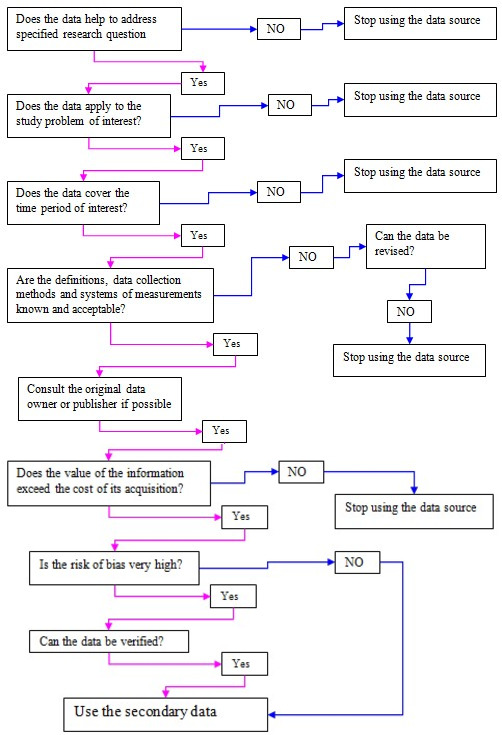
Variables of the study
The study used both dependent and independent variables (Saunders et al, 2003). The dependent variables of the study included employee relation management, recruitment policies and procedures, employee promotions policies and standards; employee competence development through training, employee ownership qualities, and cross-cultural human resource management practices; psychological contract provision, reduction of legal suits, and level of alignment of diversity and inclusion strategy into organizational strategy, the structure of the business case to manage diversity and inclusion strategy; monitoring level and its efficiencies, identification of opportunities for improvement of diversity and inclusion strategy and constraints affecting the implementation of diversity and inclusion strategy and achieved and perceived benefits of diversity and inclusion strategy, resource allocation and rationale of resource allocation, channels of communication and employee capacity to participate in diversity and inclusion strategy implementation. The dependent variables were based on four primary independent variables namely leadership and business rationale, strategic planning, execution, and results and measurements.
The study constructs
The study was constructed to utilize a Pro Mosaic II assessment tool in order to identify and determine the baseline and nature of the ServiceOntario leadership model, mentorship programs, employee relations, employee rewards schemes, employee industrial dispute management, occupational health and safety status, employee recruitment, and promotion program, employee training and development and core competencies of the human resource practices (Ospina & Sorenson, 2006).
Study design
Figure 13 (Saunders et al, 2007) illustrates the study design that was employed.

The study was designed such that it identified the theoretical framework for baselining implementation of diversity and inclusion strategy through the use of the Pro Mosaic II assessment survey. The theoretical framework facilitated the determination of the literature review based on validity determination of secondary data that had been based on the Pro Mosaic I assessment survey. The theoretical framework of the study provided the foundation for the determination of variables that influence the baselining of the diversity and inclusion strategy. The study was designed to achieve continuity of assessment based on the Pro Mosaic II assessment survey. The study was designed such that it achieved appropriation of data sets. This was carried out in order to realize the capability to manage data variability (Bryman, 2008). Management of data variability (Saunders et al, 2003) was achieved through the use of a population sample that adequately represented the targeted population. The sample population used was determined in order to ensure it didn’t impact negatively on the testability of the hypothesis. In making an assessment or evaluation of the population sample estimation, the estimate for the population sample was designed to demonstrate a high level of precision and a high level of accuracy (Gibbons et al, 2007). Precision in experimental design contributes to low variability while high accuracy levels contribute to a decrease in biasness of the data. Precision and accuracy contribute to higher reliability and inter-rater reliability or reproducibility of the study results. This required management of the errors that could impact precision and accuracy hence affecting the reliability and reproducibility of the results (Bryman, 2008). The main sources of errors that could have affected the reliability of the results (precision and accuracy dependent) and inter-rater reliability (reproducibility dependent) were determined to be natural variability of data, measurement errors due to precision level of study instruments, and systematic errors
The research design was developed such that the confidence interval had a positive relationship with a significance level (Csikszentmihalvi et al, 2006). The estimated significance level could have affected hypothesis testing thus the possibility of errors when rejecting or accepting a hypothesis. Poor estimates of significance level could result in rejection of a true hypothesis or acceptance of a false hypothesis (Bryman, 2008). The design of the study was developed such that there were no instances of using a small sample that could have resulted in a large standard error or statistical error hence loss of statistical power of the study design. This could have affected the reliability, validity, and reproducibility of the results. A large sample size does not however lead to better results and is not acceptable in some research designs (Saunders et al, 2003). For example, in a medical setting, a study cannot be designed to use many patients because the patients have the right to withdraw from the study without giving a reason for withdrawal. This follows the principle of voluntary participation in the study.
Study approach
The study relied on inductive and exploratory approaches. The induction approach was used in order to facilitate inductive determination of factors that influence the baselining of implementation of diversity and inclusion strategy (Saunders et al, 2007). The exploratory approach was adopted to bring about the equivalence of a pilot study on the organizational baseline for implementation of diversity and inclusion strategy. The exploratory nature of the study made it possible to develop questionnaires and formulate the testable hypothesis that was to form the basis for the Pro Mosaic II assessment tool.
Study setting
The study was carried out on ServiceOntario in order to determine her baseline for implementation of diversity and inclusion strategy. ServiceOntario is a ministry within the Ontario Public Service.
Research instruments
The study used questionnaires as primary research instruments. The questionnaires were presented to the study respondents for completion (Oppenheim, 2003). Questionnaires were used because they are easy to analyze using any statistical software. Questionnaires are cost-effective compared to face-to-face interview that demands a higher level of ethical issues. Written questions decrease the possibilities of interviewer bias because of uniformity in the presentation of questions to the study respondents. Compared to interviews, questionnaires do not involve any interviewing; this means that there are no verbal or visual clues to influence a respondent to answer in a particular way (Gibbons et al, 2007). Oppenheim (2003) affirms voice inflection of an interviewer has the capability to contribute to biasness that could affect the reliability and validity of the results as well as the reliability of the conclusion. Written questionnaires (Oppenheim, 2003) make it possible to avoid opportunities of interviewer biasness subject to the influence of voice inflections and its capability to interfere with respondents’ responses.
Reliability of the questionnaires
Reliability denotes the consistency element of the statistical measure. The reliability aspect was utilized to determine the change and variation of the data. The reliability consistency was determined through test-retest reliability (Bryman, 2008). Test-retest reliability was achieved through repetition of the questionnaires under the same conditions and scale on the same sample population. This was required to determine the degree of inter-rater reliability hence making it possible for the study to achieve the same outcomes if carried out by another researcher. This helped to confirm the study’s reproducibility of the results. Reliability was realized by ensuring questions meant to measure the impact of awareness were structured to measure the same characteristic element (Saunders et al, 2007).
Validity of the questionnaires
Validity was realized through measurement of specific study characteristics which was realized through face validity where question measured the construct and content validity by ensuring all aspects of construct and design were accounted for. The criterion validity or predictive validity was achieved by ensuring Likert scores predicted specific study criteria. The concurrent validity was achieved by ensuring study results were consistent with results of established measures (Saunders et al, 2007).
Questionnaire validation of the model
The questionnaire confirmed the dependent and independent variables of the study hence it was possible to infer different variables of the study. This was structured such that the results that would be obtained after data collection would be consistent with the study model (Gibbons et al, 2007). Tests runs were carried out to determine if the data collected supported the study model and ensure the questionnaire required no re-designing. The validity of the study model (Oppenheim, 2003) was evaluated on the basis of three fundamental elements of statistics that are component analytical approach, exploratory analytical approach, and confirmatory analytical approach. This made it possible to determine if the questionnaires were able to measure the expected study outcomes (Saunders et al, 2007).
The Likert scale values
The study used a six-point Likert scale (figure 14) whose values varied from zero to five.

The Study samples
The study was designed to use a sample population of 200. The respondents that finally took part in the study were 190. This showed a response rate of 95% which facilitated in demonstrating capability for the achievement of higher data reliability (Gibbons et al, 2007). The sample population was achieved through convenience sampling where the Human resource personnel for the ServiceOntario ministry determined the respondents who were to participate in the study. This was subject to accessibility of the respondent and work of the respondent during the slotted period of data collection.
Method of collecting data
Data collection involved the use of the Pro Mosaic II Diversity and inclusion assessment tool. The Pro Mosaic II diversity and inclusion assessment tool was adopted to identify activities that should form the core foundation for baselining implementation of diversity and inclusion strategy (Saunders et al, 2007). The Pro Mosaic II diversity and inclusion assessment tool was divided into four sections that sought to identify different dimensions for ServiceOntario baseline towards implementation of diversity and inclusion strategy namely leadership and business rationale, strategic planning, execution, and results and measurements for the baseline implementation. Every element that forms the structure of the Pro Mosaic II assessment tool had an independent questionnaire that focused on strategies, planning, and activities that were in place to support diversity and inclusion strategy.
Method of data presentation
The collected data was presented by using frequency distribution tables (Bryman, 2008). Tabulation was used because it makes it possible to summarize data hence facilitating in data rank-ordering as well as providing a visual representation of spread and dispersion of the collected data.
Method of data analysis
The Likert values for every question were entered into an excel database (Gibbons et al, 2007). This was followed by the calculation of the mean. The calculated mean was rounded off to the nearest unit. The means of different questions that formed a particular component for measurement were added and results were entered into a summary table (table 1).
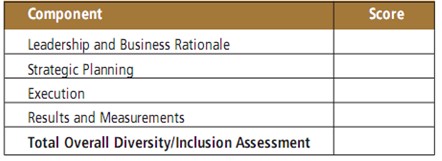
This was followed by a summation of scores of the components in order to achieve the overall score which was then plotted on a diversity and inclusion achievement continuum (figure 15).

The element of generalization of the results was implemented through analysis mapping (figure 16). This was based on the contribution of every component of the Pro mosaic II assessment tool to the diversity and inclusion achievement continuum.
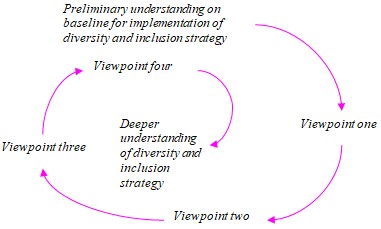
Method of data interpretation
Interpretation of the data began with the determination of mechanism through which different variables of the study contributed to the achieved results as demonstrated by the diversity and inclusion achievement continuum (Saunders et al, 2007; 2003). This paved way for the identification of components of the Pro Mosaic II assessment tool that could have contributed to the achieved results. This provided an opportunity for analysis of the continuum of the raw data, measurement of validity, and reliability of data. Data interpretation ended with the determination of internal consistency of the data hence determination of factors that impacted the baseline for implementation of the diversity and inclusion strategy based on contextual analysis.
Data validity and reliability
Data analysis was a product of validity and reliability (Bryman, 2008). This is because data credibility is an important aspect in arriving at accurate results that can lead to an informed conclusion. Accuracy of results affects the value of the study with regard to expected outcomes and the significance of carrying out the studies. Validity of the data ensured the results reflected the goals of carrying out the studies and thus contributing to accepting and rejecting of hypothesis (Saunders et al, 2007). The measures of dispersion that were calculated were subject to a correction term whose value was ±0.3.
Limitations of the study
Validity and reliability of the Likert scale measurement values
The analysis of reliability and validity of Likert scale measurement revealed that some respondents may feel uncomfortable with extreme choices on the Likert scale from zero value (Area Not Addressed) to five (Exceeds Expected Level). This might have made the respondents exhibit a feature of being unsure. In a work setting where diversity and inclusion strategy had not been communicated, it was determined that the respondents might have failed to use the extreme values on the Likert scale. This could have affected the validity and reliability of the results. The respondents could have used a similar Likert scale on a Likert scale-like ‘Exceeds Expected Level’ based on their position on the organization baseline for implementation of diversity strategy. There was also an observed disadvantage where the respondent could change the pattern by ‘disagreeing’ with statements that they might ‘agree’ on which might have affected the validity and reliability of the results (Saunders et al, 2007).
Validity and reliability of the Questionnaires
Validity and reliability tests analysis for the questionnaire model revealed that the questionnaires may have failed to bring about positive results especially if the respondent had limited reading and analytical skills. Questionnaires have the capacity to turn off respondents (Gibbons et al, 2007) hence resulting in a very small investigated sample which could have resulted in a large coefficient of variability and large mean standard error. Due to cultural factors, the interviewer’s voice inflections and mannerisms were found to have the potential to elicit bias responses from the respondents (Bryman, 2008). Although written surveys are not exposed to the disadvantage of response bias, it is not possible to probe the rationale of respondents’ choice for a given value on the Likert scale. This phenomenon arose because questionnaires often lose the ‘flavor of response’ subject to the scope and need of the respondent to quantify their responses (Saunders et al, 2003). This was managed by leaving a space where the respondent could add his comment. Questionnaires pose the threat to the researcher for not being able to know who actually completed the questionnaire (Saunders et al, 2007). In a workplace setting, the questionnaire could be handled by other employees, for instance, due to employee consultation and prevalence of low power distance, employees could discuss the questionnaires and provide collective responses or a spouse could complete the questionnaire on behalf of the respondent. There was therefore a risk that the expected respondent may not have been the one who finally completed the questionnaire.
Validity and reliability of frequency distribution tables
Frequency distribution tables were found to exhibit characteristic traits of failing to provide enough information that could be used to reveal the actual distribution of the data, a moment of skewness, and a moment of kurtosis (Gibbons et al, 2007). This limitation has the capacity of affecting the reliability of the frequency distribution tables as tools for analysis because they could have failed to reveal key patterns on the data set. Therefore key patterns of the data sets were developed to manage the disadvantage associated with the use of distribution tables.
Validity and reliability of standard error
It was revealed through validity and reliability testing that the coefficient of variability and mean standard errors could have turned out to be very large if the study relied on a small population sample. A large mean standard error and coefficient of variability could have failed to realize the significance of carrying out the studies. The study was designed to cover a large sample so that the mean standard error and coefficient of variability could be infinitesimal (Saunders et al, 2007; 2003).
Ethical concerns
The research design was structured such that it took into consideration the respondent’s autonomy (Marcoux, 2009). The study complied with the principle of voluntary participation by ensuring the respondents were educated on the objects and outcomes of the research before they finally gave their informed consent for participation. The study design was structured to conform to the element of the principle of anonymity hence ensuring responses of respondents were secured and guaranteed thus reducing the element of response biasness. The study design complied with ethical considerations for respondents’ participation in people-based research by accounting for the safety and rights of the respondents (Beauchamp et al, 1982).
References
Anderson, T., Metcalf, H., (2005) Diversity: Stacking up the evidence, London, CIPD.
Armstrong. M. A (2006), handbook of Human Resource Management Practice (10th ed.) London: Kogan Page.
Beauchamp, T.L., Faden, R.R., Wallace, R.J. amd Walters, L. (eds) (1982) Ethical Issues in Social Science Research, Baltimore: John Hopkins University Press.
Boxall, P., Purcell, J., (2003), Strategy and Human Resource Management, first edition, Palgrave.
Bryman, A. (2008) Social Research Methods, Oxford: Oxford University Press, 3rd edition.
Choi, S., & Rainey, H. G. (2010). Managing diversity in US Federal agencies: Effects of diversity and diversity management on employee perceptions of organisational performance. Public Administration Review , 70, pp.109-121.
Coran, S, Ward, L M., & Enns, J. (2003). Sensation and Perception (6th edition), Publisher: Jossey-Bass, an Imprint of Wiley.
Cordes, J.K. (2005), Developing the human capital balance sheet, Strategic HR Review, 4(3), pp. 24.
Cornelius, N. & Gagnon, S. (2004), Still bearing the mark of Cain? Ethics and inequality measurement, Business Ethics: A European Review, 13(1), pp. 26-40.
Csikszentmihalyi, M., Hektner, J. M., and Schmidt, J. A. (2006) Experience Sampling Method: Measuring the Quality of Everyday Life, Sage, London, UK.
Daniels, C. (2004), 50 Best Companies for Minorities, Fortune, 149(3), pp.136-146.
Gibbons, M.L., Lomoges, H., et al, (2007) Research methods for business students, Harlow, England, FT: Prentice Hall, Pearson Education.
Jayne, M. E., & Dipboye, R. L. (2004). Leveraging diversity to improve business.
Kalev, A., Dobbin, F., & Kelly, E. (2006). Best practices or best guesses? Assessing the efficacy of corporate affirmative action and diversity policies. American Sociological Review , 71, pp.589-619.
Kochan, T., Bezrukova, K., Ely, R., Jackson, S., Joshi, A., Jehn, K., Leonard, J., Levine, D. & Thomas, D. (2003), The Effects of Diversity on Business Performance: Report of the Diversity Research Network, Human resource management, 42(1), p. 3.
Marcoux, A. (2009), Business-Focused Business Ethics. Normative theory and Business Ethics, J. Smith. New York, Rowman & Littlefield: 17-23.
Mayo, A. (2004), Making it all add up, Personnel Today, p. 23.
McKAy, P. F., Avery, D. R., Tonidandel, S., Morris, M. A., Hernandez, M., & Hebl, M. R. (2007). Racial differences in employee retention: Are diversity climate perceptions the key? Personnel Psychology , 60 (1), pp.35-62.
Oppenheim, A.N. (2005) Questionnaire Design, Interviewing and Attitude Measurement. Basic Book, Inc, New York, pp.100-103.
Ospina, S. & Sorenson, G. (2006) A Constructionist Lens on Leadership: Charting New Territory. The Quest for a General Theory of Leadership edited by Goethals, George and Sorenson, Georgia, Edward Elgar Publishers.
Ospina, S. (2010a). Building Bridges from Margins: The Work of Leadership in Social Change Organizations. The Leadership Quarterly First Author with E.G.Foldy.
Ospina, S. (2010b) Advancing Relational Leadership Theory. Leadership Horizon Series, Eds., M Uhl-Bien and S. Ospina Greenwich, CT: Information Age performance: Research findings and recommendations for organizations. Human Resource Management , 43 (4), 409-24.
Point, S. & Singh, V. (2003), Defining and Dimensionalising Diversity: Evidence from Corporate Websites across Europe, European Management Journal, 21(6), p. 750.
Salomon, M.F. & Schork, J.M. (2003), Turn Diversity to Your Advantage, Research Technology Management, 46(4), p. 37
Saunders, M., et al. (2007), Research Methods for Business Students, third edition, Prentice Hall
Saunders, M., Lewis, P., Thornhill, A. (2003), Research Methods for Business Students, third edition, Prentice Hall.
Singh, V., Vinnicombe, S., Schiuma, G., Kennerley, M., Neely, A., (2002), Diversity Management: Practices, Strategy and Measurement, Cranfield School of Management, Cranfield University.
Stiles, P., Kulvisaechana, S, (2003), Human Capital and Performance: A literature Review, Cambridge’s Business School, University of Cambridge.
Thomas, D.A. (2004) Diversity as Strategy, Harvard business review, 82(9). p.98